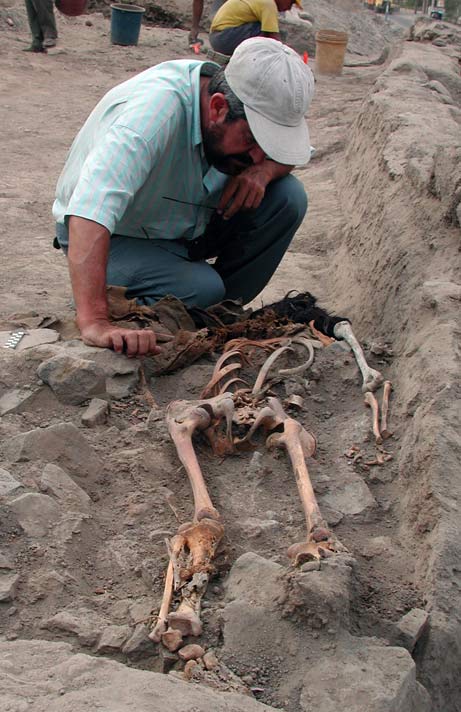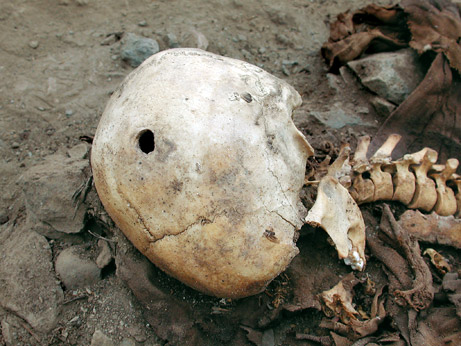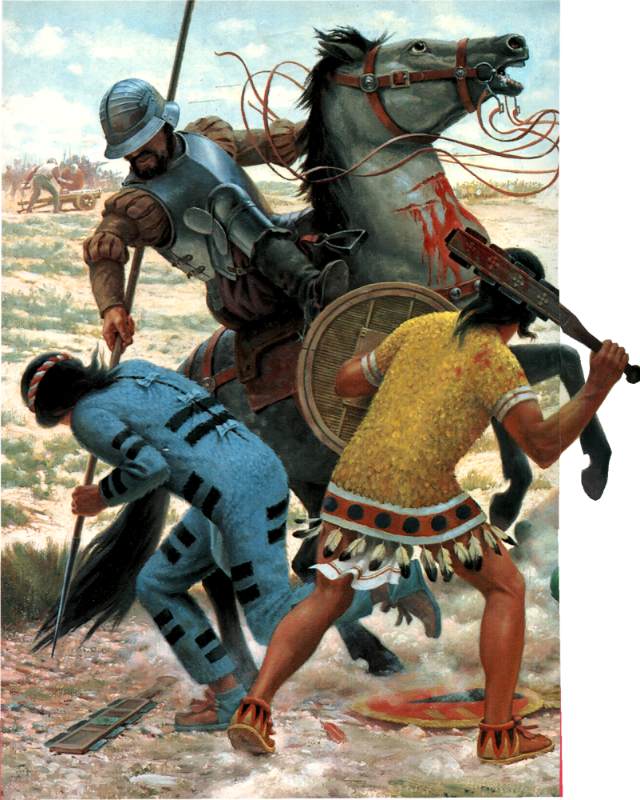Inca Skull With 16th Century Conquistador Bullet Hole Discovered in Peru
posted on June 18th, 2008 in Andes Mountains, Archaeology, Incas, Peru, Recent Discoveries
First Known Gunshot Victim in Americas Discovered
National Geographic News
June 19, 2007
The first known gunshot victim in the Americas was an Inca Indian killed by a musket-wielding Spaniard nearly 500 years ago in Peru, scientists announced today.
The casualty’s skeleton was discovered in 2004 while excavating an Inca cemetery in the Lima suburb of Puruchuco—less than a mile from thousands of Inca mummy bundles discovered by Peruvian archaeologist Guillermo Cock.
The individual may have been killed during an Inca uprising against Spanish conquistadors in 1536, according to Cock, who also led the new excavations.
Battle Scarred
The archaeologist has retrieved some 500 skeletons from the Puruchuco graves between 2004 and 2007.
Seventy-two of the individuals had been wrapped in simple cloth and chaotically buried in shallow graves. Their lack of traditional adornments and offerings—jewelry, pots for food, or headdresses, for example—suggests that the burials had been hastily prepared, as if during a period of civil unrest.
Many of the skeletons bore signs of violent hacking, tearing, and impalement with iron weapons. Notably, one of the skulls bore entrance and exit wounds like those seen in shooting victims. A small piece of bone that appeared to have been shot out of the skull was found nearby.
“We thought it was a person killed recently—5, 10 or 20 years ago,” Cock said. “We didn’t expect the individual would have been killed by a bullet 500 years ago.”

(Above: Peruvian archaeologist Guillermo Cox excavating an Inca skeleton near the shanty town of Tupac Amaru in Lima, Peru)
But the team soon realized that the individual was a Peru native dating to the Inca period, he said.
Moreover, the bone fragment showed evidence of a less forceful impact than a modern weapon would have made.
The skull fragment also bore a concave imprint suggestive of a musket ball.
Shooting Confirmed
Physical anthropologist John Verano of New Orleans’ Tulane University confirmed Cock’s initial assumptions.
Then Melissa Murphy of Bryn Mawr College—a scientist who studies human remains from archaeological settings—and archaeologist Elena Goycochea set out to help Cock confirm his theory.
They used a CT scanner at a Peruvian research facility to look for traces of metal from the musket ball around the wound and on the bone fragment.
No metal remnants were found.
But forensic experts at the University of Connecticut used a more powerful microscope to positively reveal traces of iron both places.
Iron was often used to make Spanish musket balls. Also, experts say the Inca did not know how to work iron, so the ball had to be Spanish.
“This gave us positive evidence that this individual died during conquest and was killed by gunfire,” Cock said.
“We have traces of iron on the edges of the bullet entrance and we have exit damage in the face caused by the bullet leaving the head.”
Cock and his colleagues believe the individual was killed during the siege of Lima. The 1536 uprising pitted Inca against Spanish invaders led by Francisco Pizarro.
Because women and children were found among the 72 hastily buried bodies, the team suggests that the individuals were not warriors but supporters of the warriors, such as cooks and porters.
The excavations at Puruchuco are partly funded by the Expeditions Council of the National Geographic Society, which owns National Geographic News.
Rare Proof of Brutality
Despite historical documents depicting Spanish brutality during periods of New World contact, there is little physical evidence mapping what actually happened to South Americans during and after wars of conquest, experts say.
“It is the first tangible evidence of Spanish violence towards indigenous peoples that we have from South America,” said Karen Olsen Bruhns, a San Francisco State University archaeologist specializing in Central and South America.
“This is serious collaborative research of the very best kind,” she said.
Carlos G. Elera, director of Peru’s Sicán National Museum, said, “We do not have evidence of individuals murdered by firearms and linked to the epoch of contact, except for these findings in Puruchuco.”
Since the initial find, Cock’s team has identified at least two other apparent gunshot victims. Bryn Mawr’s Murphy is surprised by the amount of evidence offered by the skeletons.
“We have worked to reconstruct the crania in order to find the point of impact, how many blows, which side of the cranium the blows were received, and whether or not we can say something about the weapon used,” Murphy said.
“We were not expecting to find as many traumatic injuries as we have so far.”


